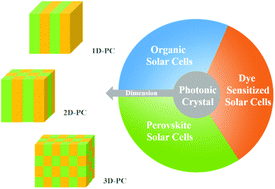Third generation photovoltaic cells based on photonic crystals
Abstract
Third-generation photovoltaic cells (PVCs) represented by organic solar cells, dye-sensitized solar cells, quantum dot solar cells and perovskite solar cells have attracted intense attention due to their low cost, light weight, flexibility and large area, enabling wide application in wearable devices, building photovoltaics and other fields. In order to meet the requirements of practical applications, PVCs need to have outstanding performance in both optics and electronics. The light management method using photonic crystals is considered to be one of the most promising methods to further improve the performance of the third generation OPVs. Benefiting from structure design combined with photonic modes such as Bloch structures, microcavity structures, and interference effects, PCs can be well-used as optics filters, reflectors, or photoanodes to intentionally enhance light trapping and color features. Creatively, third-generation PVCs based on different dimension PCs have been demonstrated by various methods and achieved excellent photovoltaic performance. This review provides a comprehensive and detailed summary of PC-based third-generation PVCs in terms of the structure design, physical mechanism and device performance.



 Please wait while we load your content...
Please wait while we load your content...